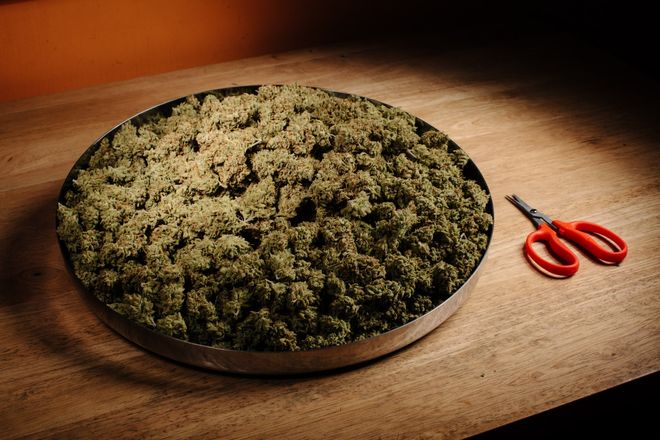How to buy high-quality cannabis produce

With legalization, there are more types of cannabis, more growers taking risks, and more experimentation with growing techniques than ever before. So what is a consumer to do? As the annual harvest of outdoor cannabis begins to hit the market, we’ve assembled a primer to getting the most bang for your buck.
Know the source
Which tastes better — grass-fed, free-range Kobe beef or vat-grown pink slime? For cannabis buyers, it means asking questions about where the plant comes from, its genetics, who grew it and how. How long was it cured? Is it lab-tested for potency, pathogens and pesticides? All this information should be available and happily shared by any respectable dispensary and well-educated budtender.
Choose boutique, small-batch bud over mass-produced monocrops, said Alix Hadley, award-winning Oakland grower and co-director of Craft Collective. Just like wine, the best small farms can reach upper echelons of quality that the most massive farms cannot.
Looks count
So you think you found some small-batch, organic bud that’s lab-tested — now look at it. Three visual clues denote quality: crystals, color and cut. Top-shelf cannabis flower buds will have visible trichomes — tiny, crystal-like resin glands on the bud’s surface that contain cannabis’ active ingredients. Trichome coverage can range from a thick, frosty coating to a light sprinkle, but if the trichomes are scarce or missing, so is the quality. A keen eye can also detect trichome maturity: White means immature, clear is mature, and amber is overripe. A nice mix of clear with a little white and amber is optimal.
Now look at the color — brown bud is bad. Brown means old and oxidized. Bud can be faded green or light purple, with pistils (the little hairs) that are orange, blond, pink or other colors. Look out for extra-bright, fresh-cut coloring. “Anything too bright is probably not quite finished yet,” said Alan Sorrentino at Craft. Other warning signs are tiny black dots (spider mite poop), white powder (mildew) or white stringy webbing (aspergillus mold).
A bud that’s crushed, compressed or crumbly-looking indicates rough handling. And check the trim job as well (the cut). The bud should look nicely manicured, but never shaved. “It’s not a topiary,” Sorrentino said. Shaving knocks off precious trichomes and can happen with careless trimmers or machine trimming.
Smell deeply
Follow your nose to cannabis you personally like. Some of the best and strongest buds can smell very pungently of citrus, pine, fuel, blueberries, candy, grape soda — or they may even smell skunk-like. Others may have just a subtle fragrance. The nose is very powerful and can instinctively detect a number of red flags as well: mold (basement smell), fungus (smelly feet), bacteria (ammonia) or inadequately flushed fertilizers (fishy or fecal). If the bud smells really grassy — like fresh lawn clippings — it probably wasn’t aged properly and won’t be tasty.
“A deep, 10-second inhale through your nose will pick up a lot of different aromas,” Sorrentino said.
Get all the feels
One drawback of modern regulations: Shops are putting bud behind the counter and prepackaging it. That’s too bad, because how a bud feels in your hand tells a lot about its dryness and its cure. Fresh cannabis is more than 80 percent water. Perfectly dried, cured pot is around 6 percent. Slow, cool air-drying followed by curing for a total of at least one month allows water to escape while holding onto the aromatic oils you’ll love. Properly cured buds will feel dense but not brittle. Bend the bud — the stem should bend, then snap. If the stem bends without breaking, it’s too wet. If it immediately snaps, it’s too dry. When you break the bud up, it should be easy to grind, and it should feel oily and sticky. It shouldn’t crumble into a fine powder (too dry) or clump into hard balls (too wet).
Burn test
“The top three characteristics I look for in quality cannabis are trichome coverage, distinct aroma and a clean burn,” says cannabis expert Ry Prichard, co-host of Viceland’s “Bong Appetit.” “Clean cannabis should burn to a white ash easily. If you see mottled black or brownish spots or there are chunks remaining that are hard to burn, that is a sign of residual nutrients and poorly flushed cannabis — the process of removing the residual nutrients from the plants prior to harvest, which greatly improves the way the plants taste.”
Craft’s Sorrentino likes to roll big joints with thin papers and take unlit drags off the end to get the taste profile. He also checks the herb’s dryness by lighting it and putting the joint down. “Can you put it down and pick it up again and is it still burning?” he said.
Fine cannabis’ smoke should hit smooth and “roll down the throat like a nice glass of water,” said Hadley. “You should be able to chug.”
Track effects
Now sit back and appreciate the experience. How do you feel? Each strain has subtly different effects, and finding your favorite is the most personal of choices. However, heavy coughing, soreness of throat, tightening of the jaw and headache are all signs something was off, Hadley said. Listen to your body, and keep track of what strains you enjoy for future reference. Vote with your dollars for higher-quality cannabis.
Dan Michaels is the author of “Green: A Field Guide to Marijuana” (2015). He lives in Connecticut. Cannabis editor David Downs contributed to this report. Downs is the co-author of “Marijuana Harvest” (2017).
